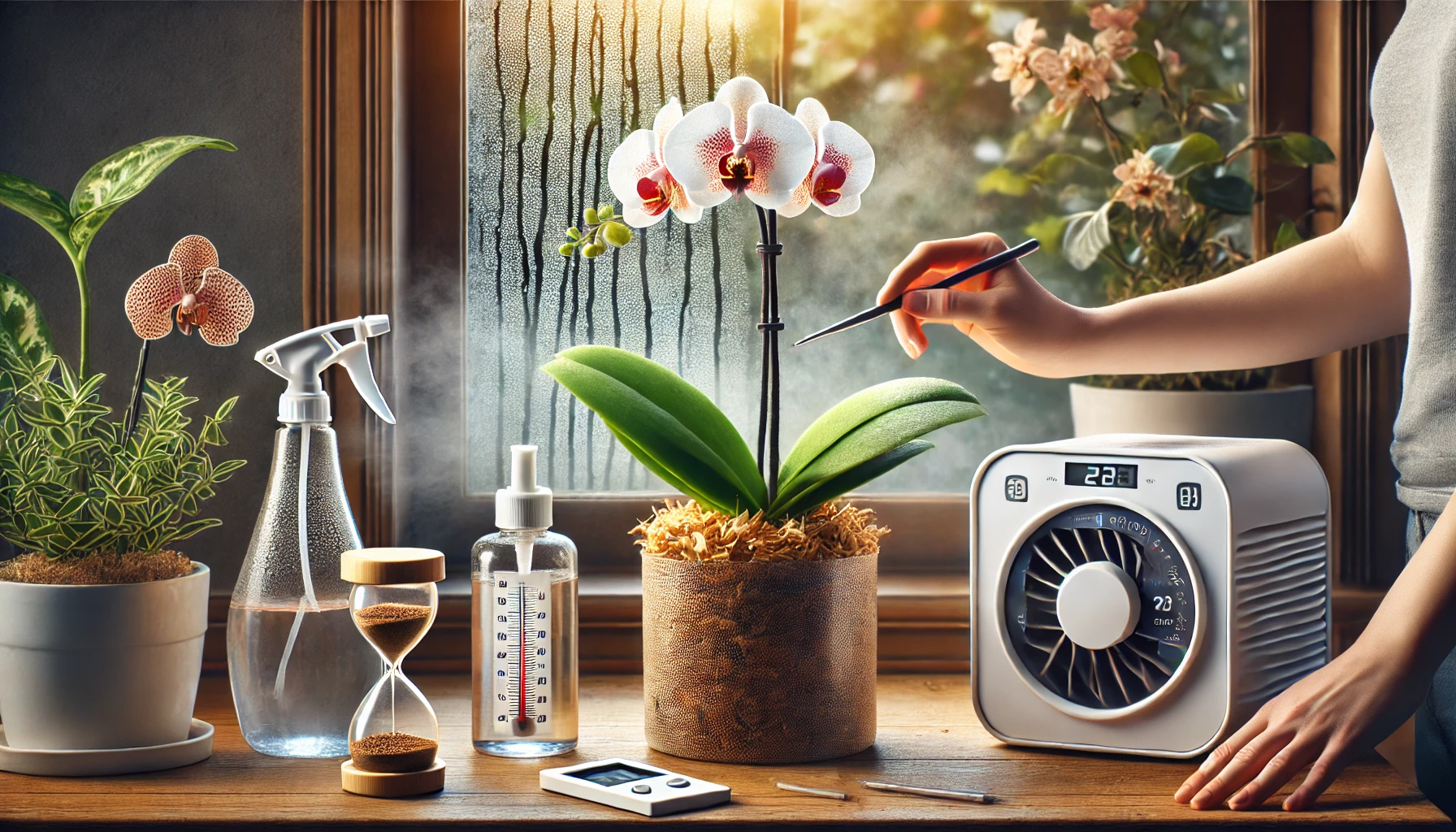Orchids naturally thrive in humid, tropical environments, making them well-suited for homes with moderate to high humidity. However, too much humidity can lead to problems such as root rot, fungal infections, and pest infestations. Learning how to balance humidity levels, improve airflow, and prevent excess moisture buildup will help keep your orchid healthy and blooming.
🌱 How Much Humidity Do Orchids Need?
Most orchids grow best in 50–70% humidity, mimicking their natural rainforest habitat. However, if the humidity is consistently above 80%, problems can arise.
✔ Ideal Humidity Ranges for Common Orchids:
- Phalaenopsis (Moth Orchid): 50–70%
- Dendrobium: 50–60%
- Cattleya: 40–60%
- Oncidium: 55–75%
- Vanda: 70–80% (higher humidity required)
💡 Humidity should be high enough to keep roots hydrated but not so high that it encourages fungal growth.
❌ Signs of Excess Humidity in Orchids
While orchids enjoy moisture, too much humidity without proper air circulation can harm the plant. Watch for these warning signs:
- Black or brown spots on leaves (fungal or bacterial infections)
- Mushy, rotting roots from excessive moisture retention
- Sticky residue on leaves from pest infestations (aphids, mealybugs)
- Mold or algae growth on the potting medium
- Weak or wrinkled leaves despite high humidity (indicating poor root health)
💡 If you notice these issues, it’s time to improve ventilation and adjust humidity levels.
🌬 How to Prevent Humidity-Related Problems
To maintain healthy orchids in high-humidity environments, follow these essential care tips:
✔ Increase Air Circulation
- Place a small fan near orchids to improve airflow and prevent stagnant air.
- Avoid grouping orchids too closely together—leave space for ventilation.
- Open a window occasionally to allow fresh air exchange.
✔ Use a Well-Draining Potting Mix
- Choose bark chips, perlite, and charcoal for fast drainage.
- Avoid overly compacted sphagnum moss, which can retain too much water.
- Repot orchids every 1–2 years to refresh the potting mix.
✔ Water Less Frequently
- In humid environments, orchids dry out more slowly, so reduce watering frequency.
- Water only when roots turn silvery-white, not on a fixed schedule.
- Water in the morning so excess moisture evaporates throughout the day.
✔ Choose the Right Pot
- Use plastic pots with drainage holes to prevent water accumulation.
- For extreme humidity, terracotta pots can help absorb excess moisture.
- Avoid decorative pots without drainage, as they trap water around the roots.
✔ Prevent Fungal and Bacterial Infections
- Wipe leaves occasionally with a damp cloth to remove excess moisture.
- Trim any black or rotting roots to stop the spread of infection.
- If necessary, apply a fungicide spray to protect against mold and mildew.
💡 Maintaining proper air circulation is the key to preventing fungal issues in high humidity!
🍃 How to Balance Humidity for Orchids
If humidity is too high, it’s important to reduce excess moisture while still keeping the environment suitable for your orchid.
✔ How to Lower Humidity in Extremely Moist Environments:
- Use a dehumidifier if humidity is above 80%.
- Move orchids to a less humid room (avoid bathrooms if they stay too wet).
- Keep orchids near an open window or under a fan for better airflow.
- Avoid misting if humidity is already high—extra moisture isn’t needed.
✔ How to Increase Humidity in Dry Areas:
- Use a humidity tray (a shallow tray filled with water and pebbles).
- Place a small room humidifier near orchids.
- Mist orchids lightly in the morning, but avoid misting flowers and crown.
💡 The goal is to keep humidity levels balanced—not too dry and not too wet!
🌸 How Humidity Affects Orchid Blooming
Humidity plays a crucial role in orchid flowering. While proper moisture levels encourage growth, excess humidity can prevent blooms from developing.
❌ How High Humidity Can Prevent Blooming:
- Too much moisture causes bud blast (flower buds drying and falling off).
- Weak root systems from overwatering prevent the plant from storing enough energy to bloom.
- Fungal infections weaken the orchid, reducing its ability to produce flowers.
✔ How to Encourage Blooms in High-Humidity Conditions:
- Reduce watering slightly to avoid overhydration.
- Provide bright, indirect light—low light can prevent flowering.
- Ensure proper nighttime temperature drops (by 10°F or 5°C) to trigger blooming.
- Use a bloom-boosting fertilizer (10-30-20) to encourage flower spikes.
💡 Balanced humidity combined with proper light and nutrients will help your orchid bloom beautifully!
🚫 Common Mistakes When Growing Orchids in High Humidity
❌ Keeping orchids in a completely closed environment – Poor airflow leads to mold and fungal infections.
❌ Using heavy, moisture-retaining soil – Orchids need bark-based mixes, not dense soil.
❌ Overwatering because of already high humidity – Less watering is needed when moisture levels are naturally high.
❌ Ignoring root health – Always check for signs of root rot or fungal issues in humid conditions.
🛡 Final Tips for Keeping Orchids Healthy in High Humidity
✔ Maintain humidity between 50–70%, adjusting as needed.
✔ Use a small fan to improve airflow and prevent fungal infections.
✔ Choose well-draining potting media and avoid compacted soil.
✔ Water less frequently and always allow roots to dry slightly between waterings.
✔ If humidity is too high, increase ventilation or move orchids to a drier area.
✔ Keep an eye on leaves and roots—healthy roots mean a healthy orchid!
By properly managing humidity, you can keep your orchids thriving, preventing common issues while ensuring strong roots, lush leaves, and vibrant blooms. 🌸✨
